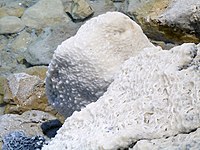
Photo from wikipedia
Background. There are laws to enforce the universal iodization of salt to check the consequences of iodine deficiency in Ghana. These laws are to ensure that there are production and… Click to show full abstract
Background. There are laws to enforce the universal iodization of salt to check the consequences of iodine deficiency in Ghana. These laws are to ensure that there are production and sales of iodized salt in the country. Yet, the availability of iodized salt in the county's households is still not encouraging, with data indicating that 93.8% of children have urine iodine <100 μg/dl. Hence, the study investigated the iodine content of salt in retail shops and knowledge of iodized salt among retailers in the Wa East District. The study will help the informed decision on strengthening and enforcing laws to achieve the universal salt iodization and the consumption of adequate iodized salt. Method. The study was a descriptive cross-sectional survey. We used a questionnaire to collect quantitative data from participants and a rapid field test kits to determine the iodine content of salt. STATA version 14.2 was used to analyse data. Chi-squared and logistic regression models were used to examine the association between the dependent and independent variables and considered p value <0.05 as statistically significant. Findings. The retailers’ primary source of information about iodized salt was health workers (46.2%), with the majority (52.8%) of them having low knowledge of iodized salt. Notwithstanding the high knowledge of iodized salt, as high as 53.8% of the salts do not have adequate iodine (<15 ppm). Retailer’s sex (p=0.014), educational level (p=0.006), primary source of information about iodized salt (p=0.012), texture of salt being sold (p=0.023), and mode of displaying salt in the shop (p=0.003) were associated with knowledge of iodised salt. Again, retailer’s educational level (p=0.036), knowledge of iodized salt (p=0.034), texture of salt being sold (p=0.021), and method of displaying the salt being sold (p=0.004) were associated with an iodine content of the salt in the shop. Conclusions. Though policies have been implemented to promote production and consumption of iodized salt, the iodine content of salt in retail shops in the Wa East are not encouraging. We recommend the establishment of checkpoints along the production and distribution chain to ensure salt with adequate iodine reaches the consumer. Again, traders of iodized salt should have regular training on ways to preserve salt to maintain its iodine content.
Journal Title: Journal of Food Quality
Year Published: 2020
Link to full text (if available)
Share on Social Media: Sign Up to like & get
recommendations!